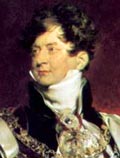 |
George Augustus Frederickb. 12 Aug 1762, London |
| Title: | Regent of the United Kingdom of Great Britain and Ireland [1] |
| Term: | 6 Feb 1811 - 29 Jan 1820 |
| Chronology: | 5 Feb 1811, An Act to provide for the Administration of the Royal Authority, and for the Care of His Majesty's Royal Person, during the Continuance of his Majesty's Illness; and for the Resumption of the Exercise of the Royal Authority by His Majesty ("Regency Act") received the Royal Assent [2] |
| 6 Feb 1811, sworn in, Carlton House, London [3] | |
| 29 Jan 1820, succeeded his father, George III, as King of the United Kingdom of Great Britain and Ireland | |
| Names/titles: | Private name: George Augustus Frederick; Duke of Cornwall and Duke of Rothesay, Earl of Carrick, Baron Renfrew, Lord of the Isles, Great Steward of Scotland [from 12 Aug 1762]; Prince of Wales, Earl of Chester [19 Aug 1762 - 29 Jan 1820]; By the Grace of God, of the United Kingdom of Great Britain and Ireland King, Defender of the Faith [29 Jan 1820 - 26 Jun 1830] (see details); König von Hannover, Herzog zu Braunschweig und Lüneburg (King of Hanover, Duke of Brunswick and Lüneburg) [29 Jan 1820 - 26 Jun 1830] |
| Biography: | |
George was the eldest son of King George III and Sophia Charlotte of Mecklenburg-Strelitz. As Prince of Wales, he became notorious for his profligacy and extravagance. He secretly married a Roman Catholic (15 Sep 1785), but less than two years later he allowed Parliament to declare the marriage illegal to obtain money for his debts. In 1795, he married his cousin, Caroline of Brunswick-Wolfenbuttel, but they became estranged after the birth of their daughter, Princess Charlotte, in 1796. When his father, who suffered dementia for years, became permanently insane, George became the prince regent under the terms of the Regency Act and was sworn in on 6 Feb 1811. The victories of the British army in the Peninsular War and the failure of the French invasion of Russia completed the defeat of Napoléon Ier. A friend of many prominent Whigs, the Prince did not use an opportunity to appoint the Whig cabinet and retained the Tory ministry of the Earl of Liverpool. In the circumstances of increasing public discontent and calls for parliamentary reform, the Prince survived an assassination attempt as he was going to Westminster to open the session of parliament (28 Jan 1817). In response to a public massacre in Manchester ('Peterloo', 1819) and other public disorder, six bills were introduced to curtail seditious meetings and newspapers. George ascended to the British throne as George IV on the death of his father after nine years of the Regency (1811-1820). The new king's public image suffered from a protracted investigation into charges of adultery against Princess Caroline (from 1820 Queen Caroline). She was refused admission to the ceremony of coronation and died on 7 Aug 1821. In 1825 speculation in stocks and shares drained the Bank of England and brought about a monetary crisis. The incapacity of the Earl of Liverpool allowed George IV to pick up his successor, George Canning, but the latter died on 8 Aug 1827. The appointment of the Duke of Wellington as First Lord of the Treasury marked the beginning of Catholic emancipation, which the king opposed. However, the Catholic Emancipation Bill, introduced in the House of Commons, was passed and received the Royal Assent on 13 Apr 1829. Biography sources: [4][5] |
|
| | |
| [1] | The Regency Act, Clause I stipulated that "His Royal Highness George Augustus Frederick Prince of Wales shall have full Power and Authority, in the Name and on the Behalf of His Majesty, and under the Stile and Title of 'Regent of the United Kingdom of Great Britain and Ireland', to exercise and administer the Royal Power and Authority to the Crown of the United Kingdom of Great Britain and Ireland (...)". Thus, the formal title of the Prince Regent was "Regent of the United Kingdom of Great Britain and Ireland". Clause II provided that, when the Royal Sign Manual of the King was required, the Regent was to sign as follows: "George P. R.", or, where it was usual to have only initials, "G.P.R." In official use, such as record of adresses to Parliament, the Regent was referred to as His Royal Highness the Prince Regent. |
| [2] | The Parliamentary Debates from the Year 1803 to the Present Time, Vol. XVIII (London: published under the superintendence of T.C.Hansard, 1812, p. 1126). |
| [3] | The records of the House of Lords and those of the House of Commons prove that both speakers of the Houses attended the Prince's swearing-in on 6 Feb 1811. As a result, the session of the House of Lords did not start before 17:00 6 Feb 1811, and the House of Commons did not convene at all on that day due to the absence of the speaker (see The Parliamentary Debates..., p. 1145). A comprehensive biography "George IV: Prince of Wales 1762-1811" erroneously asserts that the swearing-in ceremony took place on 5 Feb 1811. |
| [4] | Fryde, E.B., et al. (eds.) Handbook of British Chronology. London: Offices of the Royal Historical Society: University College, 1986. 3rd edition. online |
| [5] | "George IV: Prince of Wales 1762-1811", by Christopher Hibbert (Harper & Row, New York 1972). |
| Image: an unfinished portrait of the Prince Regent by Sir Thomas Lawrence, 1814. | |
